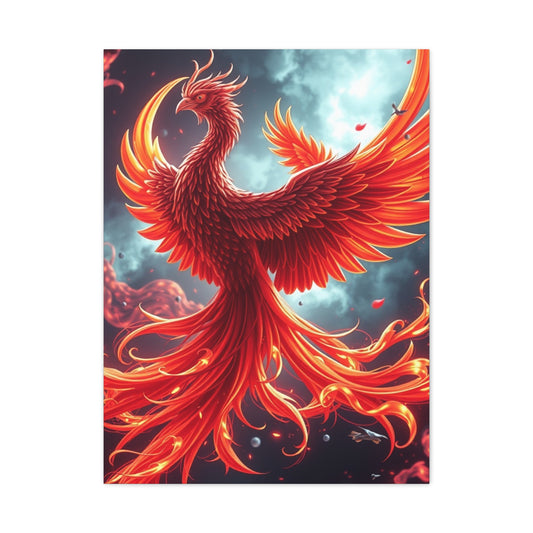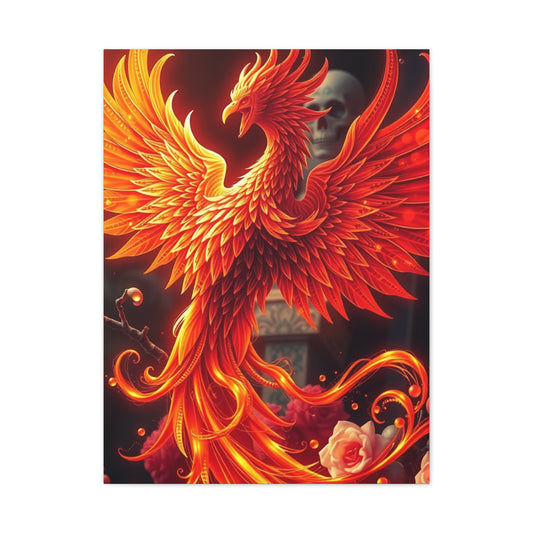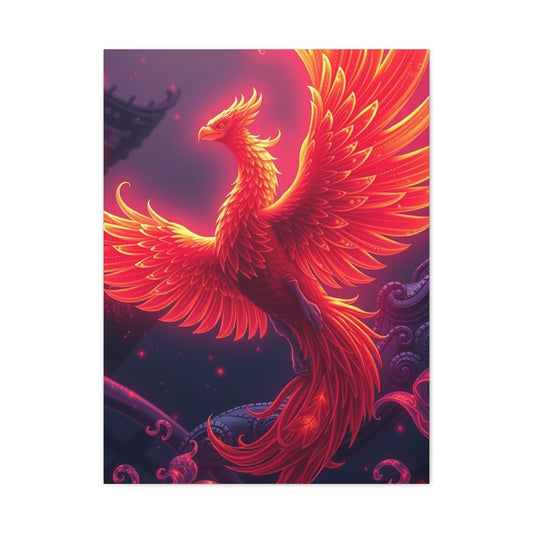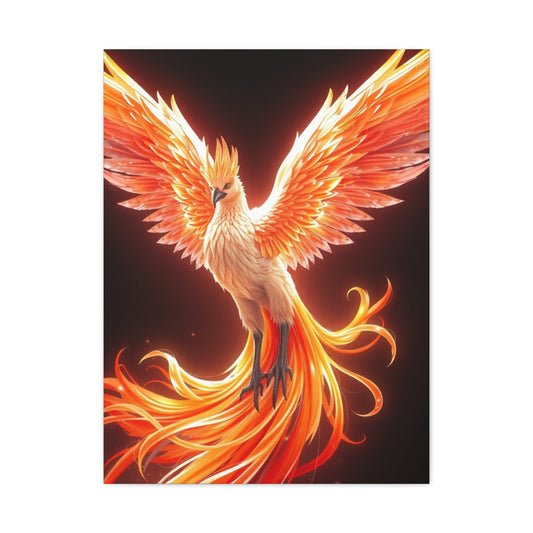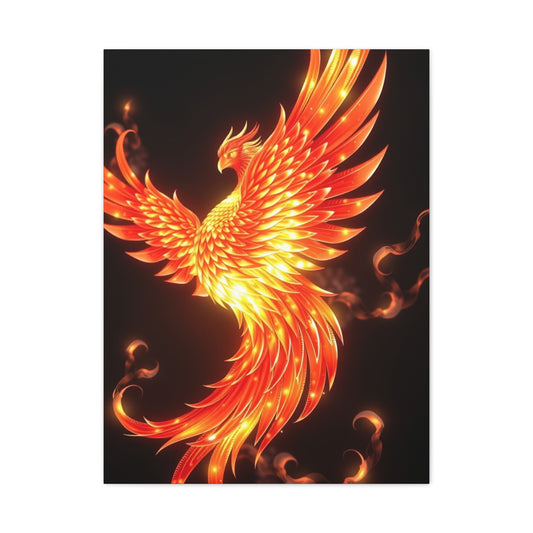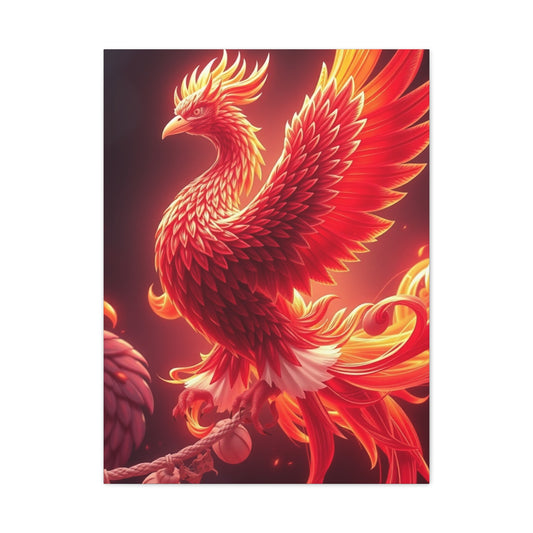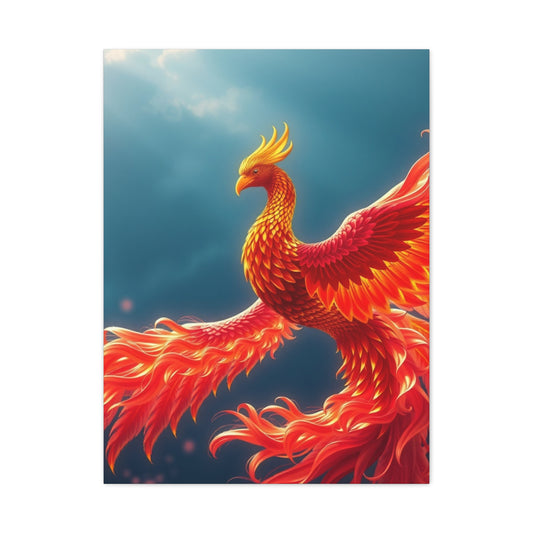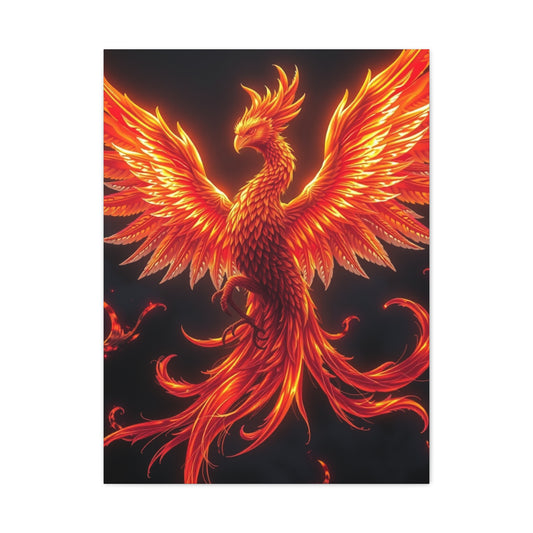Phoenix Wall Art: From Timeless Sculptures to Contemporary Creations
The phoenix, a creature of legend and imagination, has fascinated humanity for millennia. Known for its extraordinary ability to rise from its own ashes, this mythical bird embodies the eternal cycle of life, death, and rebirth. Its narrative is infused with profound symbolism, representing renewal, immortality, and the unyielding triumph of hope over despair. Across cultures and epochs, the phoenix has been depicted in art, literature, and folklore as a resplendent bird, often adorned in flaming reds and golden hues, capturing the radiant energy of fire. This association with fire not only signifies transformation but also links the phoenix to the sun, reinforcing its celestial and life-giving powers.
The allure of the phoenix lies not only in its striking visual representation but also in the philosophical and spiritual dimensions it evokes. Its myth encourages reflection on the cyclical nature of existence and the possibility of overcoming adversity to emerge renewed. Artists, writers, and scholars have long been drawn to this emblematic figure, translating its story into diverse cultural expressions, from ancient carvings and mosaics to modern installations and imaginative reinterpretations.
Historical Background
The roots of the phoenix myth extend deep into antiquity, with some of its earliest known references originating in ancient Egypt. Here, it was recognized as the benu bird, a creature often likened to a heron, associated intimately with the sun god Ra. The benu bird symbolized the eternal cycle of life, death, and rebirth, mirroring the daily journey of the sun across the sky. Ancient Egyptians revered this creature for its capacity to regenerate, viewing it as a bridge between mortality and the divine, and an emblem of cosmic order and balance.
In Greek mythology, the phoenix assumed a slightly different but equally significant role. Linked to the sun god Helios and the city of Thebes, it was believed to live for several centuries before self-immolating and emerging anew from the ashes. Greek stories highlighted the phoenix’s regenerative powers as a symbol of purification, spiritual renewal, and the indomitable force of life. Its imagery became a source of inspiration in art, literature, and philosophical discourse, emphasizing the inevitability of cyclical change and the possibility of transcendence.
The Romans further adapted the phoenix myth, intertwining it with themes of imperial authority and eternal power. Roman literature and art frequently depicted the phoenix in mosaics, frescoes, and sculptures, reflecting its association with resilience, victory over adversity, and divine sanction. In the Roman imagination, the phoenix’s self-renewal mirrored the enduring strength of the empire, reinforcing cultural ideals of continuity, power, and transcendence.
Core Concepts and Foundations
At the heart of the phoenix myth lie several interrelated concepts. First is the principle of cyclical renewal, the notion that endings are inseparable from beginnings, and that death and decay are preconditions for regeneration. The phoenix’s life cycle exemplifies this idea in literal and metaphorical terms, providing a powerful visual metaphor for natural and spiritual rhythms.
The theme of immortality is also central. Although the phoenix experiences death, it is never extinguished permanently; it reemerges in a form that is both identical and renewed. This paradoxical blend of finitude and perpetuity conveys the resilience of the spirit and the enduring nature of life itself. Additionally, the phoenix embodies hope and perseverance. Its story suggests that no matter how dire the circumstances, rebirth and renewal remain possible. This message has resonated across cultures, inspiring artistic, religious, and philosophical interpretations that underscore the transformative power of resilience.
Fire and sun symbolism underpin these core concepts. The phoenix’s immolation is not merely destructive; it purifies and energizes, allowing new life to emerge. This association with solar imagery emphasizes illumination, vitality, and celestial authority. Consequently, the phoenix is not merely a fantastical creature but a vessel of profound allegorical significance, linking the material and spiritual worlds, mortality and eternity, despair and hope.
Types and Categories
Throughout history, representations of the phoenix have varied in form, medium, and cultural nuance. In ancient Egypt, the benu bird appeared in hieroglyphic inscriptions, temple reliefs, and funerary artifacts. These depictions emphasized its connection to divinity, cosmic order, and the cyclical flow of existence. Often, the benu was shown perched or in flight, radiating solar energy, and sometimes accompanied by symbols of water, vegetation, or other elements of creation.
In classical Greece, the phoenix was frequently portrayed in mosaics, pottery, and sculptures. Its visual form often reflected artistic conventions of the period, emphasizing elegance, grace, and dynamic motion. Notably, the Roman city of Antioch produced a 2nd-century AD mosaic illustrating a phoenix rising from flames amid birds and flowers. Such depictions symbolized transformation, beauty, and the interweaving of life and death within nature’s cycles.
During the Roman period, literary and artistic forms reinforced the phoenix’s symbolic associations. Ovid’s Metamorphoses details the bird’s self-immolation and rebirth, highlighting its connection to Apollo and the sun. Roman visual arts, including mosaics and frescoes in imperial palaces, celebrated the phoenix as a symbol of endurance, power, and continuity, linking myth to political ideology.
In the Christian era, the phoenix was reinterpreted as a spiritual allegory. Early Christian artists employed the phoenix in catacomb paintings, sarcophagi, and illuminated manuscripts to represent resurrection, eternal life, and divine promise. Its emergence from ashes paralleled the resurrection of Christ and the soul’s triumph over mortality, making the phoenix a potent emblem of hope, faith, and spiritual renewal.
Medieval and Renaissance artists expanded the phoenix’s symbolic range, incorporating it into heraldry, literature, and painting. The phoenix’s journey from destruction to rebirth was mirrored in the human spiritual path, while its fiery plumage symbolized courage, strength, and divine inspiration. Renaissance painters often linked artistic creation to the phoenix’s cycle, suggesting that creativity itself involved destruction, transformation, and renewal.
Practical Applications
The phoenix myth continues to influence modern culture, art, and thought. In literature, film, and popular media, the phoenix frequently symbolizes resilience, regeneration, and the human capacity to overcome adversity. Its story resonates in educational and motivational contexts, where it serves as a metaphor for personal growth, recovery, and the renewal of purpose.
In the visual arts, the phoenix inspires contemporary installations, sculptures, and multimedia works. Artists such as Ai Weiwei have employed phoenix imagery to explore themes of social resilience and human endurance, while others, including Louise Bourgeois and Anish Kapoor, use it to examine grief, transformation, and cyclical patterns in life and nature. Its symbolism informs not only aesthetic creation but also the philosophical interpretation of existence, encouraging reflection on mortality, creativity, and renewal.
Moreover, the phoenix functions as a metaphor in organizational, cultural, and psychological frameworks. In business or educational contexts, it represents adaptability, the capacity to emerge stronger from failure, and the enduring potential of innovation. Psychologically, it embodies resilience, optimism, and the regenerative power of the human spirit, reminding individuals and communities of the cyclical nature of challenges and renewal.
The phoenix’s enduring appeal demonstrates its flexibility as a symbol. Whether interpreted in mythological, artistic, spiritual, or psychological terms, it communicates the universal truth that destruction is not an end, but a prelude to transformation. Contemporary artists and thinkers continue to reinterpret the phoenix for new audiences, translating ancient wisdom into modern contexts. Its narrative reinforces hope, perseverance, and the eternal potential for growth, renewal, and transcendence.
Through its appearances in mythology, art, literature, and cultural consciousness, the phoenix bridges temporal and spatial boundaries. From ancient Egypt to contemporary installations, from classical mosaics to modern cinematic representations, it serves as a testament to humanity’s fascination with life’s cyclical nature. The phoenix encapsulates the paradox of mortality and immortality, despair and hope, endings and beginnings, making it a timeless emblem of transformation and resilience.
In sum, the phoenix in mythology exemplifies a complex interplay of symbolism, history, and cultural resonance. Its story is not confined to the past but continues to inform and inspire present and future generations. As a symbol of rebirth, renewal, and transcendence, it invites reflection on life’s rhythms, the inevitability of change, and the enduring capacity to rise above adversity. The phoenix’s legend persists not only as a mythical narrative but also as a cultural and artistic touchstone, celebrating the transformative power inherent in all living beings and creative endeavors.
Techniques and Methods
Throughout history, artists and creators have employed diverse techniques to capture the phoenix’s ethereal essence. In ancient Egypt, hieroglyphic inscriptions relied on stylized depictions, combining symbolic geometry with meticulous craftsmanship to convey both the bird’s physical form and its cosmic significance. The benu bird was often rendered in profile, its elongated neck and radiant plumage evoking solar energy, while its placement within temples and tombs emphasized its association with divine order and regeneration.
Greek artisans developed mosaics, pottery, and sculptural reliefs to articulate the phoenix’s story visually. Mosaics, in particular, allowed for intricate color gradations, capturing the fiery vibrancy of the phoenix’s plumage and the transformative act of rising from ashes. Artists would select tesserae in subtle gradations of red, gold, and orange to suggest motion, warmth, and renewal. Sculptors employed bronze, marble, and terracotta, shaping wings in dynamic poses that suggested flight, emergence, and rebirth, thereby reinforcing the narrative of cyclical life and purification.
Roman and early Christian artists adapted these techniques, integrating the phoenix into decorative frescoes, illuminated manuscripts, and sarcophagi. Fresco painting required mastery of wet plaster and pigment blending, enabling delicate transitions of color to evoke the radiant aura of the bird. Illuminated manuscripts relied on gold leaf and meticulous miniature detailing, rendering the phoenix as a jewel-like emblem of resurrection and eternal life. In each context, the choice of medium and method served both aesthetic and symbolic purposes, reinforcing the phoenix’s role as a bridge between mortality and transcendence.
In modern art, techniques expand beyond traditional media. Contemporary painters employ mixed media, layering acrylics, oils, and metallic pigments to suggest the interplay of fire, ash, and renewal. Installation artists utilize sculpture, light, and kinetic elements to create immersive experiences where the phoenix appears to rise from simulated flames or suspended environments. Digital art introduces animation and interactive elements, allowing viewers to witness the bird’s rebirth in a temporal sequence, bridging mythology with modern technology. These varied methods underscore the adaptability of the phoenix as an artistic motif and its continued relevance across media and eras.
Challenges and Common Mistakes
Depicting the phoenix presents several artistic and conceptual challenges. A primary difficulty lies in balancing symbolic meaning with visual representation. Artists must convey the transformative essence of the phoenix while maintaining aesthetic coherence. Overemphasis on literal fire or overly dramatic forms can obscure the subtlety of renewal and cyclical symbolism. Similarly, focusing solely on realistic bird anatomy can diminish the mythical and transcendent qualities that define the phoenix in legend.
Color selection is another common challenge. The phoenix’s association with fire, light, and vitality necessitates a careful palette. Inadequate contrast or over-saturation may dilute the intended impact, whereas insufficient attention to tonal transitions can render motion and rebirth static rather than dynamic. In mosaics, the meticulous placement of tesserae is critical; misalignment or inconsistent shading can disrupt the visual flow, compromising the sense of ascension and transformation.
Cultural misinterpretation also constitutes a challenge. The phoenix appears in diverse mythologies, from Egyptian benu to Greek and Roman variations, and Christian symbolic reinterpretations. Artists unfamiliar with these historical contexts may inadvertently merge elements incongruently, creating visual or conceptual dissonance. Similarly, contemporary reinterpretations risk flattening the phoenix’s multifaceted symbolism into a generic motif of fire or strength, neglecting its profound spiritual and philosophical resonance.
Technical limitations in modern installations can also pose obstacles. Sculptural works requiring kinetic movement, light effects, or complex materials must account for structural integrity, safety, and viewer interaction. Digital art may face challenges in rendering fluid transitions or simulating ashes realistically, while ensuring engagement with the narrative rather than only visual spectacle. Artists must navigate these technical and conceptual complexities to preserve the phoenix’s essence while innovating within their medium.
Trends and Future Outlook
The phoenix remains a vibrant and evolving symbol in contemporary artistic expression. Current trends emphasize experiential and immersive art, where the viewer participates in witnessing the phoenix’s transformation. Augmented reality installations allow audiences to observe the bird rising from ashes in real time, combining mythology with digital interactivity. Light and projection art, often in public spaces, create ephemeral and dynamic interpretations that echo the transient yet regenerative nature of the phoenix, making the myth tangible in the modern environment.
Sustainability and material innovation also influence phoenix representations. Contemporary artists increasingly explore recycled, biodegradable, or unconventional materials to craft phoenix sculptures and installations, symbolically aligning the myth of renewal with ecological consciousness. Kinetic and modular designs are gaining popularity, enabling components of the phoenix to move, change, or reassemble, thereby enacting the bird’s transformative cycle physically and conceptually.
Narrative integration has expanded beyond visual media. Phoenix symbolism now informs storytelling, interactive experiences, and immersive performances. Literature, film, and digital gaming leverage the phoenix as a motif of resilience and regeneration, extending its cultural relevance and interpretive potential. In educational and therapeutic contexts, phoenix-inspired programs and visualizations promote reflection on personal growth, resilience, and cyclical change, demonstrating the enduring applicability of this mythological figure.
Future artistic exploration is likely to further fuse technology, symbolism, and audience interaction. Artificial intelligence, generative art, and virtual reality may allow artists to create phoenix experiences that adapt to viewer input, offering personalized narratives of rebirth and transformation. Collaborative installations could incorporate environmental data or community participation, reinforcing the phoenix as both a personal and collective symbol of renewal. The myth’s adaptability ensures its continued resonance across diverse cultural and technological landscapes.
Expert Insights
Scholars and contemporary artists emphasize that the phoenix’s enduring power lies in its versatility and rich symbolic depth. Art historian Marianne Delacroix notes that the phoenix functions as both an icon and a metaphor, capable of conveying spiritual, social, and psychological narratives without reliance on literal depiction. By balancing mythological fidelity with creative interpretation, artists can evoke the bird’s transcendent qualities while engaging modern audiences in meaningful ways.
Contemporary sculptor Elias Navarro observes that creating phoenix installations requires an understanding of rhythm, material behavior, and viewer perception. He highlights the importance of integrating kinetic elements and light to convey the cyclical essence of rebirth effectively. Navarro argues that successful phoenix representations blend visual spectacle with conceptual clarity, ensuring that transformation remains central rather than purely ornamental.
Digital artist Aria Chen emphasizes the potential of interactive and generative media in Phoenix art. By programming virtual phoenixes to respond to environmental variables or user interactions, Chen creates dynamic interpretations where the myth evolves with participation. This approach underscores the adaptability of the phoenix narrative, demonstrating its relevance not only as a static symbol but as an evolving experience that engages audiences across temporal and cultural boundaries.
Cultural commentators also underscore the phoenix’s role as a metaphor for resilience and adaptation in broader social contexts. Its story resonates in times of upheaval, environmental concern, and personal transformation. By maintaining fidelity to the core themes of cyclical renewal, hope, and immortality, contemporary applications of phoenix imagery reinforce the enduring human fascination with overcoming adversity and achieving regeneration.
The phoenix continues to inspire multidisciplinary exploration, from visual and digital arts to literature, performance, and psychology. Experts advocate for approaches that honor historical context while embracing innovation, ensuring that each iteration of the phoenix communicates both the myth’s ancient roots and its modern relevance. The bird’s symbolic richness enables ongoing reinterpretation, allowing artists and scholars to probe existential, spiritual, and societal themes through the lens of this extraordinary mythological creature.
Across eras, the phoenix demonstrates an unparalleled capacity to bridge tradition and innovation, myth and modernity, materiality and abstraction. Its narrative invites contemplation on cycles of destruction and renewal, personal and collective transformation, and the intricate interplay between mortality and immortality. In both ancient mosaics and contemporary installations, the phoenix remains a potent emblem of enduring hope, resilience, and the continuous possibility of rebirth.
As artistic techniques evolve, the phoenix is likely to maintain its relevance, offering limitless avenues for exploration. Whether expressed through classical sculpture, immersive installation, or digital interaction, the phoenix embodies timeless truths about the human experience: the inevitability of change, the promise of renewal, and the inexhaustible potential to rise from ashes stronger, wiser, and more radiant.
Emerging Trends in Wall Art
Wall art has evolved remarkably over recent decades, embracing innovative materials, techniques, and concepts that redefine its role in contemporary spaces. Modern audiences seek more than decorative appeal; they desire immersive experiences, narratives, and emotional resonance. Among the most prominent trends is the integration of technology, with interactive installations, projection mapping, and augmented reality reshaping how wall art is perceived. These innovations allow viewers to engage dynamically with art, transforming static surfaces into responsive, evolving canvases that convey movement, transformation, and narrative depth.
Sustainability and ecological awareness have emerged as influential forces in wall art creation. Artists increasingly utilize recycled, reclaimed, or biodegradable materials, crafting installations that echo the cyclical nature of life and the environment. This approach resonates conceptually, particularly when exploring themes of rebirth, renewal, and continuity, aligning with the symbolic essence of motifs such as the phoenix. Incorporating natural fibers, reclaimed metals, and repurposed wood into wall art emphasizes environmental responsibility while adding unique textures and tactile dimensions that enrich viewer engagement.
Another rising trend is the blurring of boundaries between art forms. Wall art now often integrates sculpture, lighting, textiles, and mixed media, producing multidimensional pieces that challenge traditional definitions of two-dimensional expression. For example, layered panels, suspended elements, and kinetic components allow art to project beyond the wall, creating depth, shadow, and perspective that respond to spatial dynamics. This hybridity encourages audiences to experience wall art as a spatial encounter, fostering deeper interaction and interpretation.
Personalization and customization are also gaining momentum. Advances in digital fabrication, including 3D printing and laser cutting, enable bespoke wall art tailored to individual aesthetic preferences, spatial requirements, and thematic interests. Customized wall art bridges personal narrative with artistic expression, transforming walls into sites of identity, memory, and introspection. In addition, digital platforms allow consumers to visualize potential installations in their own spaces, democratizing design and bridging the gap between creator and audience.
Cultural cross-pollination has influenced wall art aesthetics, blending traditional motifs with contemporary sensibilities. Artists are reinterpreting mythological, historical, and folkloric imagery through modern media, producing works that resonate with global audiences while preserving cultural nuance. Mythical figures, symbolic animals, and historical emblems, such as the phoenix, are rendered in diverse styles, materials, and scales, reflecting the intersection of heritage and innovation. This synthesis enriches the visual language of wall art, offering layered meanings and aesthetic complexity.
Color and texture continue to play central roles in emerging wall art trends. Vibrant, gradient-rich palettes evoke emotion and narrative, while layered textures, from embossed surfaces to mixed-media reliefs, invite tactile engagement. The manipulation of light and shadow amplifies these effects, enhancing perception and creating dynamic atmospheres. Such attention to chromatic and material detail transforms wall art into an immersive medium capable of conveying energy, transformation, and cyclical symbolism with heightened subtlety.
Experiential and participatory installations are also increasingly prevalent. Artworks that invite viewer interaction, whether through touch, motion, or sound, create a dialogue between observer and object. This engagement fosters a sense of co-creation, where the audience becomes part of the artwork’s unfolding narrative. Immersive wall art thus transcends decorative function, evolving into an experiential medium that explores identity, memory, and transformation in tangible, resonant ways.
Wall art is also embracing temporality and ephemerality as conceptual tools. Installations crafted with perishable materials or designed for short-term exhibition reflect themes of impermanence, cyclical renewal, and the passage of time. These transient works resonate conceptually with motifs of rebirth, capturing the delicate tension between destruction and regeneration. The integration of natural elements such as plants, sand, or water further emphasizes life cycles, connecting the artwork to organic processes and reinforcing symbolic depth.
Curatorial and spatial considerations are redefining wall art as well. Contemporary practitioners treat walls as canvases for narrative journeys, arranging multiple works to guide viewers through thematic or emotional arcs. This approach draws on principles of rhythm, contrast, and visual storytelling, transforming individual pieces into a cohesive narrative ecosystem. Such arrangements often incorporate architectural features, light sources, and ambient conditions to amplify the immersive quality, blurring the line between artwork and environment.
Digital and virtual platforms are shaping wall art consumption and dissemination. Online galleries, virtual exhibitions, and augmented-reality overlays allow artists to reach global audiences while preserving the integrity of their creative vision. Digital wall art can be programmed to evolve, integrating motion graphics, interactive overlays, and generative elements. This fusion of technology and traditional artistry expands the conceptual and aesthetic possibilities of wall art, enabling continuous innovation and dialogue between creator and audience.
Step-by-Step Guides
Creating compelling wall art requires both technical precision and conceptual clarity. Understanding the foundational steps ensures that each installation communicates effectively and resonates with its audience. The first stage is conceptualization, where the artist identifies the thematic core, narrative intention, and emotional resonance of the piece. For motifs rooted in symbolism, such as the phoenix, this stage involves studying mythological, historical, and cultural references, distilling the essence of transformation, renewal, and resilience into a coherent artistic vision.
Sketching and preliminary design follow, translating abstract concepts into visual structures. Artists explore composition, color palettes, and spatial dynamics, balancing symbolic representation with aesthetic appeal. In this phase, attention to scale, proportion, and perspective ensures that the work functions harmoniously within the intended environment. Layering, texture, and material considerations are also incorporated, enhancing visual depth and tactile engagement.
Material selection constitutes the next crucial stage. Traditional media such as canvas, wood, metal, and stone remain popular, while contemporary practices incorporate recycled materials, textiles, plastics, and digital interfaces. The choice of medium influences both the conceptual resonance and practical durability of the wall art. Artists often experiment with hybrid materials, combining contrasting textures or reflective surfaces to amplify symbolic meaning and create visual intrigue.
Execution requires technical skill and attention to detail. Painting and drawing demand mastery of brushwork, layering, and pigment blending to convey motion, luminosity, and narrative clarity. Sculptural and installation work requires precise measurement, structural integrity, and sometimes kinetic engineering to ensure stability and interactive functionality. Digital elements involve coding, projection mapping, or generative design, requiring fluency in software tools and programming techniques. Throughout execution, fidelity to the original concept and careful integration of symbolic elements maintain the thematic integrity of the artwork.
Finishing and refinement are integral to ensuring that wall art achieves both aesthetic and conceptual impact. Surface treatment, color correction, and textural enhancement help unify the visual narrative. Lighting design can dramatically alter perception, highlighting dynamic features or casting symbolic shadows. In installation contexts, spatial orientation, viewer sightlines, and ambient interaction are considered to optimize engagement. Each adjustment refines the dialogue between artwork and observer, ensuring clarity, resonance, and transformative potential.
Presentation and contextualization extend the artwork beyond creation into perception. Wall art benefits from thoughtful placement within architectural or environmental contexts. Curators and artists consider ambient light, surrounding textures, and viewer pathways to maximize emotional and narrative impact. Interpretation may be enhanced with supplementary information, interactive elements, or guided experiences, enabling audiences to engage more fully with symbolic motifs and immersive storytelling.
Evaluation and iterative refinement complete the process. Artists and observers assess the effectiveness of symbolic representation, technical execution, and emotional impact. Feedback informs potential modifications or future iterations, reinforcing the cyclical nature of artistic creation, akin to the regenerative symbolism of the phoenix. This reflective practice ensures that wall art remains both meaningful and responsive to evolving aesthetic, cultural, and technological trends.
Emerging artists are increasingly encouraged to integrate interdisciplinary perspectives, combining mythology, environmental awareness, psychology, and technology in their wall art practices. Such integration expands the depth, resonance, and versatility of installations, allowing contemporary audiences to experience art as both a visual spectacle and a conceptual exploration. By embracing experimentation, meticulous technique, and symbolic integrity, practitioners can create wall art that is both timeless and timely, evoking reflection, emotion, and transformation.
Innovation in stepwise methodology also emphasizes narrative sequencing and experiential engagement. Multi-panel arrangements, interactive pathways, and kinetic sequences allow wall art to unfold progressively, mirroring symbolic journeys of transformation. Viewers encounter visual arcs, thematic shifts, and dynamic elements that reinforce concepts of renewal, resilience, and continuity. This narrative structuring transforms wall art into a medium that not only decorates but also educates, inspires, and immerses.
Collaboration and cross-disciplinary approaches are increasingly prevalent in modern wall art creation. Artists work with architects, technologists, engineers, and performers to craft installations that integrate spatial, kinetic, and interactive dimensions. Such collaborative practices expand both the aesthetic potential and experiential depth of wall art, aligning with contemporary expectations for multisensory engagement and conceptual richness.
Finally, the evaluation of wall art trends emphasizes longevity and adaptability. Pieces are designed to resonate across temporal, cultural, and spatial contexts, retaining relevance as technologies, spaces, and audiences evolve. By anchoring design in enduring symbolic themes while embracing innovation, wall art continues to offer profound insights, emotional resonance, and aesthetic pleasure. Emerging trends underscore the capacity of wall art to transform spaces, narrate human experience, and mediate between historical legacy and contemporary imagination.
Future Outlook in Wall Art
Wall art continues to evolve as an expressive medium, bridging tradition, technology, and human imagination. The future of wall art will likely emphasize immersive experiences, where audiences engage with artwork in ways that transcend conventional observation. Virtual and augmented reality are poised to expand these possibilities, allowing viewers to explore layered narratives, dynamic transformations, and interactive environments that adapt in real time. Artists increasingly experiment with programmable surfaces, projection mapping, and motion-sensitive installations, transforming walls into living canvases that respond to light, sound, and viewer interaction.
Sustainability will remain a guiding principle in future wall art. As global awareness of environmental impact deepens, artists are exploring renewable materials, low-energy digital displays, and biodegradable installations. The symbolic resonance of natural cycles, regeneration, and rebirth aligns with ecological consciousness, making wall art not only visually engaging but conceptually significant. Reclaimed metals, recycled plastics, natural fibers, and organic pigments provide texture, color variation, and narrative depth, reinforcing the cyclical essence that is central to motifs such as the phoenix.
Technological integration will continue to redefine the boundaries of wall art. Generative algorithms, artificial intelligence, and kinetic engineering offer unprecedented possibilities for creating responsive and evolving pieces. These methods allow artworks to change over time, interact with environmental factors, or adapt to viewer behavior, creating a symbiosis between audience and medium. The phoenix motif, for instance, can be rendered digitally to rise and transform repeatedly, mirroring the narrative of regeneration and resilience while providing a constantly evolving visual experience.
Globalization and cross-cultural synthesis are shaping aesthetic trends. Artists increasingly draw inspiration from diverse mythologies, historical traditions, and indigenous narratives, blending them with contemporary design, technology, and symbolism. The phoenix, with its deep roots in Egyptian, Greek, Roman, and Asian mythologies, exemplifies this synthesis. Modern interpretations may combine sculptural elements, digital animation, and interactive projections to create wall art that honors historical origins while resonating with contemporary audiences. This convergence ensures that wall art remains relevant, accessible, and globally appealing.
Emerging trends also emphasize audience participation and co-creation. Interactive wall art transforms viewers into collaborators, allowing personal gestures, choices, or motion to influence visual outcomes. Such engagement deepens emotional resonance and creates a sense of ownership over the artwork’s narrative. Experiential art spaces, where visitors navigate through sequences of panels, kinetic elements, or immersive projections, encourage reflection on themes of rebirth, continuity, and resilience, reinforcing the transformative power of wall art.
Curatorial practice in wall art is evolving to encompass narrative coherence, environmental integration, and multisensory engagement. Future exhibitions will likely prioritize storytelling, arranging pieces to create visual arcs and thematic progression that guide viewers through emotional or conceptual journeys. Lighting, acoustics, and spatial dynamics are increasingly integral, emphasizing the relational interplay between wall art, architecture, and observer. This approach transforms the wall from a passive surface into an active stage for narrative exploration, reinforcing the immersive potential of contemporary art.
Digital platforms are expanding the reach and accessibility of wall art. Virtual galleries, online marketplaces, and augmented-reality applications allow artworks to transcend physical limitations. Digital wall art can incorporate animation, interactivity, and generative design, offering experiences that evolve with viewer input or environmental conditions. Artists can reach global audiences, fostering cultural exchange and democratizing access to sophisticated visual narratives. In this context, wall art becomes both an aesthetic and a conceptual bridge, linking individual creativity to collective experience.
The future of wall art also emphasizes emotional and psychological impact. Research into human perception and environmental psychology informs the design of color, texture, and spatial composition. Walls can be curated to influence mood, cognition, and sensory awareness, creating restorative, contemplative, or stimulating experiences. Symbols such as the phoenix amplify this effect, evoking hope, resilience, and the possibility of renewal. Artists are increasingly aware that wall art can be more than decorative; it can actively shape emotional landscapes and inspire reflection on personal and collective growth.
Collaborative practice will shape the evolution of wall art. Interdisciplinary projects involving artists, architects, engineers, technologists, and environmental specialists allow the creation of hybrid works that combine narrative, kinetic movement, and immersive environments. These collaborations produce multi-layered experiences where symbolism, aesthetics, and audience engagement converge, reflecting both technological sophistication and deep cultural resonance. In the case of mythological motifs, such as the phoenix, interdisciplinary methods enable the creation of installations that simultaneously honor tradition and innovate with contemporary forms.
Urban spaces will increasingly serve as canvases for large-scale wall art, merging public art with architectural design. Murals, interactive installations, and projection mapping can transform cityscapes, offering communal engagement and shared cultural experiences. By embedding wall art into the urban environment, artists amplify the visibility and accessibility of transformative symbols. The phoenix, with its themes of resilience and renewal, resonates particularly strongly in public contexts, offering hope and inspiration within dynamic, ever-changing urban landscapes.
As wall art continues to evolve, conceptual experimentation will drive innovation. Artists are exploring temporal elements, multisensory integration, and narrative sequencing to produce works that are not static objects but evolving experiences. Ephemeral installations, kinetic structures, and digital projections extend the lifespan of artistic expression while emphasizing impermanence, regeneration, and cyclical transformation. This focus reflects both aesthetic innovation and philosophical engagement, highlighting the capacity of wall art to engage viewers intellectually, emotionally, and spiritually.
Education and training in wall art practices are adapting to these emerging trends. Curricula increasingly emphasize multidisciplinary skillsets, including digital media, environmental design, cultural literacy, and symbolic interpretation. Artists are encouraged to engage with historical motifs, technological tools, and psychological principles to create works that are aesthetically sophisticated, conceptually rich, and experientially immersive. By cultivating technical proficiency alongside interpretive insight, future practitioners can continue to expand the possibilities of wall art while maintaining thematic coherence and symbolic depth.
Wall art also remains a conduit for social commentary and cultural dialogue. Contemporary artists employ murals, installations, and digital projections to address environmental, social, and political themes, using symbolism to engage audiences in reflective and transformative experiences. The phoenix, as an emblem of rebirth and resilience, provides a potent narrative framework for addressing collective challenges, inspiring hope, and fostering a sense of shared continuity in times of uncertainty.
The role of wall art in therapy and well-being is expanding. Symbolic and immersive installations are increasingly used to promote mental health, creativity, and emotional processing. Motifs representing regeneration, such as the phoenix, can facilitate reflection on personal challenges, resilience, and transformation. Therapeutic wall art integrates aesthetic experience with psychological insight, underscoring the profound potential of visual storytelling to influence mood, cognition, and personal growth.
In conclusion, the future of wall art is characterized by innovation, interactivity, and conceptual depth. Emerging trends emphasize technology, sustainability, audience engagement, and cross-cultural synthesis, allowing artists to expand the expressive potential of walls while maintaining symbolic resonance. Motifs like the phoenix continue to inspire, bridging historical tradition and contemporary exploration, and offering narratives of hope, transformation, and renewal. Wall art remains a dynamic medium, capable of transforming spaces, engaging communities, and communicating profound human truths across generations.
Conclusion
Wall art, as both a visual and conceptual medium, has demonstrated extraordinary versatility, evolving from ancient hieroglyphs and classical mosaics to modern installations and digital experiences. Its enduring power lies in the capacity to convey complex narratives, evoke emotional resonance, and engage audiences across temporal, cultural, and spatial contexts. Motifs such as the phoenix exemplify the symbolic richness of wall art, embodying themes of renewal, resilience, and cyclical transformation that continue to inspire artists and viewers alike.
Historically, wall art has reflected societal values, spiritual beliefs, and philosophical ideas. From the Egyptian benu bird to Roman mosaics, Christian iconography, and Renaissance interpretations, artists have explored themes of life, death, and regeneration, translating mythology and allegory into compelling visual forms. These traditions inform contemporary practices, providing a conceptual and aesthetic foundation for innovative approaches in both physical and digital media.
Modern wall art integrates diverse techniques, materials, and technologies, enabling artists to experiment with dimensionality, interactivity, and narrative sequencing. Mixed media, kinetic installations, augmented reality, and digital projections expand the expressive possibilities, allowing audiences to engage with art as an evolving, participatory experience. Sustainability, ecological consciousness, and cultural cross-pollination further enrich contemporary wall art, linking material practice with symbolic meaning.
Stepwise methodologies ensure that wall art maintains coherence and impact, from conceptualization and design to execution, refinement, and presentation. Attention to color, texture, spatial composition, and symbolic integrity allows artworks to communicate effectively and resonate deeply. Narrative structuring, immersive experiences, and audience engagement transform wall art from a decorative function into a medium of emotional, intellectual, and spiritual reflection.
The future of wall art is poised to further integrate technology, sustainability, and interdisciplinary collaboration. Artists will continue to explore interactive, responsive, and immersive installations, expanding the boundaries of visual storytelling. Globalization, cultural exchange, and technological innovation offer unprecedented opportunities to reinterpret traditional motifs, such as the phoenix, ensuring relevance across generations and geographies.
Ultimately, wall art is more than ornamentation; it is a vehicle for expression, reflection, and transformation. Symbols of rebirth, resilience, and continuity inspire audiences, offering hope and encouragement in an ever-changing world. By bridging past and present, tradition and innovation, wall art remains a vital and dynamic form of human creativity, capable of communicating universal truths, shaping environments, and enriching lives. The phoenix, as an enduring emblem, exemplifies the timeless potential of wall art to evoke wonder, inspire renewal, and celebrate the indomitable spirit of creativity.


